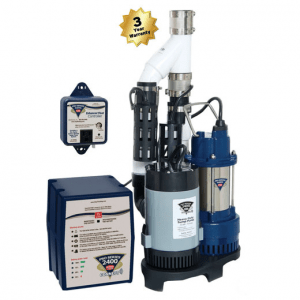Battery Backup
Apr 16, 2018When you go the full length to waterproof your basement, it’s always upsetting when you wake up to water in your basement after a storm. To prevent this from happening, we highly recommend installing a battery backup pump with your sump pump. Having a battery backup protects you from power outages and primary pump failures. When the power goes out, our backup systems automatically switch from AC power to DC, running off a battery until power is restored. Once power is restored, the primary pump will come back on and the battery for the backup should recharge, as long as the battery life doesn’t deplete any lower than 25% of the battery’s total charge.
For those of you who aren’t familiar with battery backups within sump pump systems, we want to inform you on the advantages of having both a primary and a backup pump (with a backup battery) installed within your basement. Our S3 Series Sump Pump is paired with a PHCC-2400 backup pump, which combines both a primary and secondary pump. Having the combination of pumps working together in a system where a backup battery is present allows water to continue to be drained even when the primary pump is down either because of electrical failure or mechanical malfunction. The backup battery will autonomously turn on in the absence of the primary pump, and in addition, will aid the primary pump if its working too hard, in order to maximize efficiency.
The backup battery is a product that we highly encourage, as it can make a huge difference in the dryness of your basement during situations where the power could potentially go out. This backup battery ensures piece of mind that no matter what the circumstances, your basement sump pump system will continue to keep your basement dry. Our Battery Backup Pumps have decades of proven reliability and have a complete monitoring system to alarm you whenever there is an issue.
The backup pump will kick on when:
- The primary pump fails or is clogged with debris
- You lose power
- The float switch on your main pump fails or gets stuck
- If the discharge is clogged or frozen
- There is an excessive inflow of water and the primary can’t keep up




